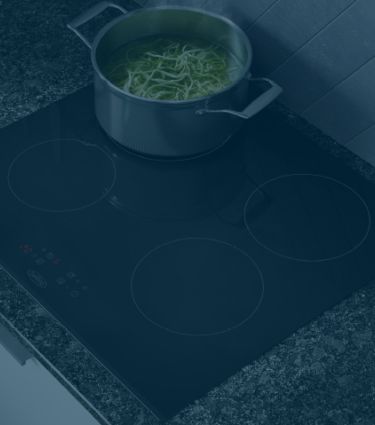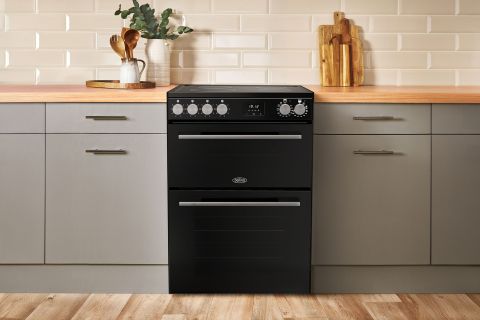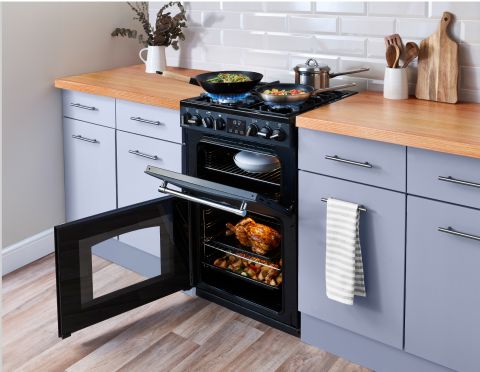
Built In Hobs FAQs
- The built-in gas hobs have a ½ inch BSP parallel gas connection, with an internal (female) elbow connector, in the rear-right-hand corner of the hob when looking at the appliance from the top.
- Yes, built-in gas hobs can be converted from natural gas to LPG.
- The LPG conversion kit is available as an optional extra. For currently available models, please use LPG conversion kit 013342493 for 60cm 4 ring gas hobs (GTG603RI, GHU603CI, GHU603RI, GHU602GC) or LPG conversion kit 013342494 for 75cm 5 ring gas hobs (GTG753RI, GHU753CI, GHU753RI, GTG75C). View spares
Gas Hobs:
- Usually rated at 3-amp or 13-amp and come with a cable and a three-pin plug.
- Ensure the plug socket is accessible after installation, such as in an adjacent cupboard.
- A gas connection is also required.
Electric Ceramic and Induction Hobs:
- Require hardwiring into a 32-amp fused spur cooker point.
- Fuse ratings are calculated based on real-life usage, as not all elements operate at full power simultaneously.
13 Amp Induction Models:
- Can be connected to a standard 13 amp three-pin plug and socket.
For safe installation, consult a qualified electrician. Gas hobs must be installed by a Gas Safe-registered fitter.
- On models with gas hobs, please use pans with a base diameter of between 120mm-180mm on small burners, 180mm-200mm on medium burners, 180mm-220mm on large burners, and 200mm-260mm on wok burners.
- Use pans with smooth, flat bases for optimal stability and heat distribution.
- Please use pans with a base diameter of at least 120mm on small rings and at least 145mm on medium and large rings.
- As a rule, induction hobs work well with pan base sizes up to 30mm smaller or larger than the ring printed on the glass. Induction hobs cannot recognise pans with base diameters of less than 100mm.
- Please ensure that the base of the pan is smooth, flat and magnetic across the diameter of the base.
- For best results it is very important to use a pan which is of the same size as the ring printed on the glass – usually 145mm diameter base for smaller rings and 180mm diameter base for larger rings.
- Smaller pans would allow unused heat to build-up around the pan, potentially leading to the hob over-heating and cutting out, or to damage of the glass surface.
- Using a slightly larger pan than the ceramic glass ring can help to produce more gentle simmering.
- Yes, that is normal.
- The ceramic hob elements are thermostatically controlled, and so the elements are switched on and off at required intervals to maintain the power level required and to prevent over-heating.
- This is completely normal for models with 6 heat settings per hob ring (the control knob clicks as you adjust the heat).
- Lower Power Levels: Only parts of the ceramic element glow red.
- Power Level 6: The entire ceramic element lights up.
This is how the hob regulates heat and ensures efficient energy use. Do not stare directly at ceramic rings in operation.
- Please note that some models feature a child-lock to prevent the hob zones being switched on. Please deactivate the child-lock if appropriate. For further information, please consult the user manual for your model.
- You may hear some soft clicking when the induction coil is switched on or off, and some soft buzzing relating to friction creating heat in the pan base.
A crackling sound when using your induction hob is normal in some cases. Here’s how to minimise it:
- Make sure the base of the pan and the ceramic glass are completely dry. Moisture can cause a crackling sound during operation.
- Noises may be more noticeable at higher power levels. Lowering the power setting can reduce the sound.
- The type of pan you use matters. Pans with a higher amount of magnetic material in their base tend to be quieter.
- Yes, this is perfectly normal and will not affect cooking results.
- Induction hobs work differently from ceramic hobs as they use induction coils rather than heating elements. These coils generate a magnetic field that heats the pan directly through friction in its magnetic base.
- The hob’s electronics pulse the power on and off to maintain the selected power level:
- At lower power settings, the coil is on for shorter periods and off for longer periods.
- At higher power settings, the coil is on for longer periods and off for shorter periods.
- This process ensures the pan does not overheat and that the requested power level is maintained, delivering consistent cooking performance.


